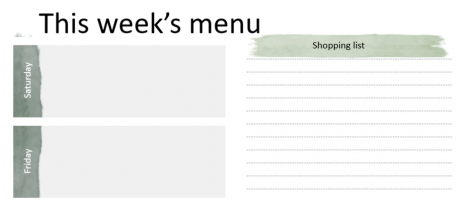Meal planning is essential to a successful healthy diet. It will prevent grabbing something that you probably shouldn’t be eating when you don’t have anything planned for dinner. If it’s a quick snack to hold you over until the meal, at least it should be a wise choice. A plan helps you to stock up on healthy options.
- The planning should begin before you head to the grocery store. Once a week sit down and create a menu plan for the meals you are going to make for the next week. Include all meals and snacks for each day. Include raw veggies for snacks, such as bell peppers, celery, cucumbers, broccoli, and cauliflower.
- Then prepare a list of the ingredients you need for your week’s pre-planned meals. Shop from the list to prevent “oh, that looks good” i
 mpulse buying. You can use a digital program to have it handy on your phone or tablet. We’ve used Wunderlist, Todoist, and others to build our lists. When we add the item to the cart, we check it off and it drops into the completed list. Then when we need it again, we scroll down and uncheck it so it goes back to the active shopping list.
mpulse buying. You can use a digital program to have it handy on your phone or tablet. We’ve used Wunderlist, Todoist, and others to build our lists. When we add the item to the cart, we check it off and it drops into the completed list. Then when we need it again, we scroll down and uncheck it so it goes back to the active shopping list. - In the beginning, meal planning will take some time. Once you get the first week or two done, it will get easier and take less time. You might even decide that you’ll come up with 2 weeks of variety and then duplicate those 2 weeks as many times as you wish. If you are no longer using that menu plan, file it for later. When you need to come up with menu ideas and you are short on time or ideas, pull out the tried and true menu and you’re all set.
- If you’re following a specific diet such as Paleo, Carb counting, the TLC Diet, or Omni diet, you’ll need to know what foods you can have, the portion sizes and how they can be cooked. If you are not following a specific diet plan, then be sure you know what foods are best. While specifically targeting diabetics, my book Overcome Diabetes has detailed information that applies to healthy meal plans for everyone. Plan your meals around those.
The short version: eat more veggies, eliminate sugar and simple carbs, eat more whole foods.
- Plan each day out in its entirety. Make it realistic. Don’t plan to make a meal that requires a lot of prep/cook time on a night that you know you won’t be home until late. Save the meals with more preparation for when you have time and make extra so you can have left-overs. If you are going to do this, you can plan the left-overs into the week’s menu.
- Don’t go to the grocery store when you are hungry. If you do, there is more chance that you will buy food that you do not need. As you’re pushing around the cart, only get what is on your list. Skip the aisles that don’t have something on the list (cuts down on temptation.)
- Before you get in line to pay for your food, make sure nothing jumped into your cart that you shouldn’t have. Put it back. My husband sometimes puts things like cookies into the cart to see how long it will take me to notice. Not very long 🙂
These 7 tips will make sure you stick to your meal plan and save you money too.
We’ve followed two specific diets in the past. Now we follow the wise choice foods listed in my book. These foods have become a habit. If my husband goes to the store to replenish supplies, I know he’ll come home with good choices from our shared digital list. There are times when we splurge, but we know that’s what it is – a one-time splurge.
To your health!
Marian Hays writes, coaches, and speaks about health and personal growth for people who want to take control of their health and empower their lifestyle. She’s an advocate for others as she researches and shares the truth instead of hype, infused with humor. Her goal is to inspire others to accomplish their goals and work through challenges that might otherwise hold them back. You can find her books on Amazon.
